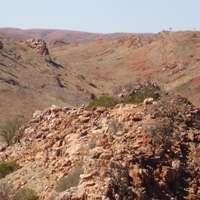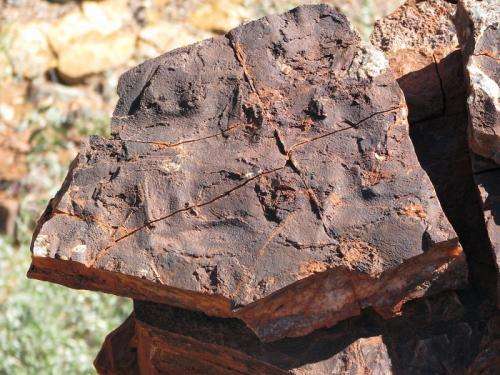Pilbara home to 3.5 billion-year-old bacterial ecosystems

(Phys.org) —Evidence of complex microbial ecosystems dating back almost 3.5 billion years has been found in Western Australia's Pilbara region by an international team including UWA Research Assistant Professor David Wacey.
The research, published this week in the journal Astrobiology has revealed the well-preserved remnants of a complex ecosystem in a 3.5 billion-year-old sedimentary rock sequence.
Professor Wacey said identifying and reconstructing Earth's earliest biosphere was challenging because the oldest sedimentary rocks were not only rare, but also almost always changed by hydrothermal and tectonic activity.
"The Pilbara region of Western Australia is one of the rare geological regions that provides insight into the early evolution of life on Earth," he said.
"Mound-like deposits created by ancient bacteria, called stromatolites, and microfossils of bacteria have previously been discovered in this region. However, a phenomenon called microbially induced sedimentary structures, or MISS, had not previously been seen in rocks of this great age."
MISS were created by microbial mats as the microbial communities responded to changes in physical sediment dynamics, Professor Wacey said.
"A common example would be the binding together of sediment grains by microbes to prevent their erosion by water currents," he said. "The significance of MISS is that they not only demonstrate the presence of life, but also the presence of whole microbial ecosystems that could co-ordinate with one another to respond to changes in their environment."

Professor Wacey, based at the ARC Centre of Excellence for Core to Crust Fluid Systems, the Centre for Microscopy, Characterisation and Analysis, and the Centre for Exploration Targeting, worked with US colleagues Nora Noffke and Daniel Christian of Old Dominion University, and Bob Hazen of the Carnegie Institute Washington.
The team described the various MISS from the ancient coastal flats preserved in the Dresser Formation and found close similarities in both form and preservation style to MISS in younger rocks.
Associate Professor Noffke, lead author of the paper, said the research extended the geological record of MISS by almost 300 million years and showed that complex mat-forming microbial communities likely existed almost 3.5 billion years ago.
MISS are among the targets of Mars rovers, which search for similar biological signals on that planet's surface. Hence, the team's findings could be significant for studies of life elsewhere in our solar system.
More information: online.liebertpub.com/doi/pdfp … 0.1089/ast.2013.1030
Journal information: Astrobiology
Provided by University of Western Australia





















